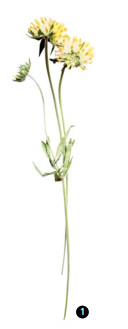The hills are alive with botanical treasures, and one brand has gone to great lengths to bottle their benefits.


He sports no dusty fedora and carries no bullwhip. Nor does he dress in khakis and a beaten leather jacket. But there are good reasons why Nicola Fuzzati is known as the Indiana Jones of Chanel.
Like his movie counterpart, Fuzzati is a knowledge seeker and treasure hunter who travels to far-flung locations all around the world to uncover new finds. Except that while Indy goes after archaeological riches, Fuzzati forages for botanical gems – plants, herbs and flowers that hold significant value for skincare.
A phytochemist by training, he attained his PhD from the University of Lausanne’s School of Pharmacy, which is renowned for plant research. Then he worked at a pharmaceutical company in his native Italy, developing plant-based antitumour drugs. When he joined Chanel in 2012, it was a perfect fit, the brand sharing his zeal for botanical science. “In Italy, I was the expert for European medicinal plants. So studying plants is really going back to what I know best,” he says.
As director of active ingredient development and innovation, Fuzzati carries out explorations in biodiversity hotspots across the globe, setting up partnerships with local authorities to find the most interesting botanicals for skincare. It was in the southern French Alps, an area known for its rich cache of medicinal plants, that he discovered the desirable qualities of solidago and anthyllis – the two herbs that now star in the latest offerings from Chanel’s top-end antiageing line, Sublimage.
This was the culmination of a laborious two-year process in which Fuzzati and his team researched more than 500 Alpine plants, whittling down the field to around 60, then performing chemical analyses to identify their components. The most promising options were put through further testing before these two were finally chosen.
Solidago, a plant with yellow flowers that grows around the mountain range’s rocky foothills, became the cornerstone of Sublimage L’Essence Fondamentale ($750), a serum which promises to tone, tighten and restore plumpness to sagging skin. “Solidago means ‘I consolidate’ in Latin, and that is exactly what it does for skin. It is listed in European pharmacopoeia as an antiinflammatory drug and is used in medicine, usually as an infusion that you drink,” he says. In the serum, solidago is used with the aim of preventing cell damage by inducing more production of a protein called SNEV that keeps skin structure strong and prevents cells from degrading.
Anthyllis, too, is a medicinal plant with yellow blooms. Its full name in Latin – anthyllis vulneraria – means “wound healer”, as it was traditionally applied directly onto injuries. Found in sunny places high in the Alps, it produces molecules that work as UV-quenchers, soaking up the sun’s strong rays. “Often, plants living in difficult climate conditions develop their own defences. They produce molecules with special functions to help them survive,” explains Fuzzati.
Those defensive molecules are the reason Chanel chose anthyllis as the key element in Sublimage L’Essence Lumiere ($750), a serum for brightening and anti-dark spot action. The brand found that when the serum is applied to skin, it boosts production of an antistress protein which controls pigmentation and reduces oxidation. For city dwellers whose constant exposure to pollution and environmental stress results in dull skin and uneven tone, it’s a godsend.
To ensure the solidago and anthyllis it uses are of top quality, with optimum amounts of active ingredients, Chanel set up an open-sky laboratory in the southern French Alps where it can cultivate its own crops in a place that’s controlled yet is within the plants’ natural environment. The lab also functions as a research station for local, Alpine and Mediterranean plants.
Fuzzati says: “The open-sky lab is where we can be in close contact with nature and develop our knowledge of the plants, such as their ideal growing conditions. We see how they behave in nature and study how best to cultivate them – a very difficult process, because these are wild plants that nobody has tried to grow before. For solidago, it took us four years to reach an industrial production level.”
He likens the lab and its aims – botanical studies out in nature and sustainable cultivation – to the Garden of Plants (Jardin des Plantes) in Paris. Once known as the King’s Garden, this fourcentury-old public park spans 28 hectares and was a medicinal garden for Louis XIII in its early years. Now, it’s the headquarters for the French National Museum of Natural History and has four galleries, including the Gallery of Botany, which has the world’s largest herbarium, housing nearly eight million plant species.
“The Jardin des Plantes became the place where explorers from the New World would bring their plants to be acclimated. It’s a source of inspiration for me because what I’ve done in the Alps is to keep the plants in the wild and cultivate them there for production. This is similar to what was done in the King’s Garden,” says Fuzzati.

“The open-sky lab is where we can be in close contact with nature and develop our knowledge of the plants.”



3 Sublimage L’Essence Fondamentale works like a mesh over skin to smooth and firm it.
4 The light-textured, easily-absorbed Sublimage L’Essence Lumiere refreshes your skin.























